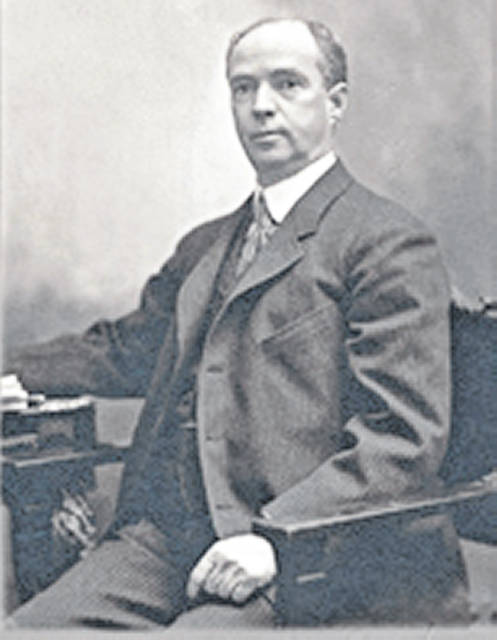
John D. Archbold was born in Leesburg in 1848 to the Rev. Israel Archbold and Frances Foster Dana. From an early age, he was tasked with taking care of his small family when his two older brothers moved away. When he was only 11, Archbold was forced to support his mother and younger sister when his father passed away. By the time he was 16, he heard rumors of an oil boom in Pennsylvania, where a hard-working man could earn enough money to send home to his family. He immediately set out for the oil fields and began to work.
By age 19, his investments began to pay off and he was able to send his younger sister to college and buy a new home for his mother. In Pennsylvania, Archbold found success as a refiner and buyer of oil, starting his own company called Acme Oil. In 1870, he met and married the beautiful socialite Annie Eliza Mills and purchased a sprawling mansion in Tarrytown, New York, the notorious neighborhood that was home to some of America’s most famous millionaires. He called his home Cedar Cliff, and its remarkable architecture and Victorian grandeur drew admiration from the entire community.
By this time, he had made a name for himself in the oil industry and was rapidly gaining clients and profits from his hard work and smart business deals. It wasn’t long until Standard Oil took notice of Acme’s success and bought out the smaller company, although Archbold was originally a critic of Rockefeller. Archbold’s reason for selling out was that he believed the oil fields of Pennsylvania were to soon be depleted and that oil would no longer be widely available for refining. He was so confident that upon hearing reports of oil discoveries in Oklahoma in 1885, he exclaimed, “I’ll drink every gallon produced west of the Mississippi!”
Before its dissolution in 1911, Archbold served as director, vice president and president of the Standard Oil Company. From 1911 to 1916, he was president of the Standard Oil Company of New Jersey. He was successful beyond most people’s wildest dreams. While his exact net worth wasn’t known, it’s estimated that he would be a millionaire in today’s money.
The people loved Archbold. He was the epitome of the American Dream; a man who worked his way up from rural Ohio to become one of the most powerful people in America at the turn of the century. A 1907 Marion, Ohio newspaper article that was reprinted around the country read, “Standard’s Real Head; John Dustin Archbold, boss of the big combine, works while Rockefeller sleeps.” He was the relatable underdog and the real boss of Standard Oil. While John Rockefeller was a controversial billionaire, the other John D. was a humble millionaire, someone the people could love, and he capitalized on this media portrayal as much as he could.
But not everyone was an Archbold fan. While he wasn’t leading one of the largest oil operations in America, he was getting involved with politics; albeit, illegally. In 1912, Archbold and John D. Rockefeller were at the center of a bribe scandal involving the Republican Party and the Theodore Roosevelt administration. In 1912, he testified in front of an investigation committee that Roosevelt knew about a $125,000 contribution from the Standard Oil Company, a value worth over $3 million in 2021. Roosevelt produced letters that proved to the committee his administration refused any gifts offered. The case was dismissed, but Archbold’s reputation was slightly tarnished.
After this scandal and the rise of labor organizers seeking better working conditions for employees, Archbold had his fair share of critics. With great power and wealth come enemies, and he had plenty of them. In 1915, his gardener stumbled upon a large dynamite explosive at the entrance of the Cedar Cliff mansion. Thankfully, the bomb was contained before it could cause anyone harm. Police suspected radical members of the Industrial Workers of the World (IWW) organized the assassination attempt. The event occurred just one day after the execution by firing squad of Joe Hill, an IWW organizer that had been convicted of murder in what many considered to be an unfair trial. The attempt on Archbold’s life was likely a direct consequence of the execution.
Archbold has a complicated legacy. He was a philanthropist, donating large sums of money to Syracuse University, the National Kindergarten Association and many other organizations of the time. He was the target of a failed assassination attempt, embroiled in a scandalous bribery scheme, and a close confidante of the richest American to ever live. When he died in 1916 from complications related to appendicitis, he left significant donations to Syracuse University, where the John Dustin Archbold School of Liberal Arts was formed in his honor.
He is buried in Sleepy Hollow, New York, in a marble mausoleum alongside his wife.
Sources for this story were: https://www.mausoleums.com/portfolio/archbold-mausoleum/ https://library.syr.edu/digital/guides_sua/html/sua_archbold_jd.htm
Isabella Warner is a stringer for The Times-Gazette.


